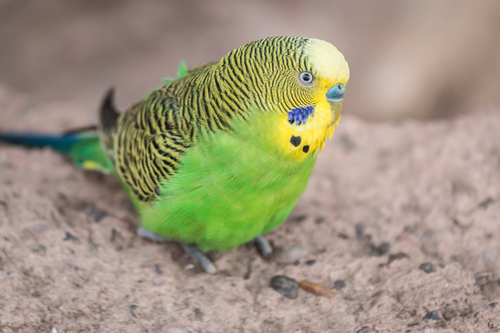
Budgerigar
The Budgerigar (Melopsittacus undulatus), commonly known as the 'budgie,' is a small, long-tailed, seed-eating parrot. Wild budgerigars are found throughout the drier parts of Australia, where they have survived harsh inland conditions for over five million years. They are naturally green and yellow with black, scalloped markings on the nape, back, and wings, but in captivity, they have been bred to display a variety of colors, including blue, white, yellow, and grey. Their small size, vibrant colors, and ability to mimic human speech have made them popular pets worldwide. Ecologically, budgerigars play a role in seed dispersal and are an important prey species for larger birds and reptiles.
18-20 cm
Length
25-30 cm
Wingspan
Least Concern
Conservation Status
Distribution
Native to Australia, budgerigars are widely distributed across the continent's interior, particularly in arid and semi-arid regions. They are nomadic, moving in response to the availability of food and water. While not typically migratory in the classic sense of fixed seasonal routes, their movements can cover large distances.
Lifespan
In the wild, budgerigars typically live for 3-6 years. In captivity, with proper care, they can live for 7-15 years.
Budgerigar's Habitat
Habitat Types
Grasslands, Savannas, Open woodlands, Shrublands
Climate Zones
Arid, Semi-arid, Temperate (in some coastal areas)
Adaptations
Budgerigars are well-adapted to dry environments. They can obtain much of their water needs from their food (seeds) and have efficient kidneys to conserve water. Their nomadic behavior allows them to exploit patchy and unpredictable resources.
Variations
While no formally recognized subspecies exist, slight variations in size and plumage intensity have been observed across different regions of Australia, likely due to local environmental conditions.
Appearance
Breeding Plumage
Wild-type budgerigars have green underparts, yellow upperparts, and black scalloped markings. Captive-bred varieties exhibit a wide range of colors. There's no significant difference between breeding and non-breeding plumage.
Seasonal Feather Changes
No significant seasonal variation.
Sex Based Plumage Differences
Adult males typically have a blue cere (the fleshy area above the beak), while females have a brown or tan cere, especially when in breeding condition.
Notable Features
Undulating flight pattern, Prominent cere, Long, tapered tail feathers
Diet and Feeding
Primary Foods
Grass seeds, Seeds of herbaceous plants
Foraging Behavior
Budgerigars primarily forage on the ground, often in large flocks. They are opportunistic feeders, taking advantage of available seed sources. They use their beaks to husk seeds efficiently.
Specializations
Their strong, hooked beaks are well-suited for cracking open seeds. They also have a crop, a specialized part of the digestive system, that allows them to store food temporarily.
Seasonal Diet Variations
Their diet varies depending on the availability of seeds, which is influenced by rainfall and the seasonal growth of grasses and other plants. During droughts, they may rely more on seeds from drought-resistant plants.
Behavior
Social Structure
Budgerigars are highly social birds, often forming large flocks, especially when foraging or roosting. These flocks can number in the thousands, particularly around water sources.
Communication
Chirps, Chatters, Warbles, Squawks, Body language (e.g., head bobbing, feather fluffing)
Migration
While not truly migratory, budgerigars are nomadic, moving in response to food and water availability. They do not follow set routes but rather wander erratically.
Territorial or Group Behaviors
Budgerigars are not strongly territorial, except perhaps around nest sites. Their large flocks provide protection from predators through increased vigilance.
Conservation
Threats
Habitat degradation (due to grazing and agriculture), Predation by introduced species (e.g., feral cats), Climate change (increased frequency and severity of droughts)
Protection Programs
General wildlife protection laws in Australia
Local National Laws
Protected under Australian law, but not considered threatened or endangered.
Population Trend
Stable
Population Estimates
The global population is estimated to be very large, possibly numbering in the millions, although precise figures are difficult to obtain due to their nomadic nature.
Interesting Facts
Budgerigars can see ultraviolet light.
This ability likely helps them find food and mates, as some seeds and feathers reflect UV light.
They grind their beaks to keep them in good condition.
This behavior, often heard as a quiet clicking sound, helps to wear down the beak and prevent overgrowth.
Budgerigars have monocular vision.
Their eyes are positioned on the sides of their heads, giving them a wide field of view but limited depth perception.
They are one of the few parrot species that can be reliably sexed visually.
The color of the cere (the fleshy area above the beak) differs between adult males and females.
Faqs about Budgerigar
Can budgerigars talk?
Yes, budgerigars are capable of mimicking human speech, although their vocabulary is typically smaller than that of larger parrots. Males are generally better talkers than females.
What is the difference between a budgie and a parakeet?
Budgerigar is the specific name for *Melopsittacus undulatus*. 'Parakeet' is a general term for many small to medium-sized parrot species with long tail feathers.
Are budgerigars good pets?
Budgerigars can make excellent pets due to their small size, social nature, and ability to bond with their owners. They require proper care, including a spacious cage, a balanced diet, and social interaction.
Do budgies need a companion?
While they are very social, a single budgie can thrive with enough human attention. However, if left alone for long periods, a companion budgie is recommended.
How can I tell if my budgie is healthy?
Healthy budgies are active, alert, and have smooth feathers. Signs of illness include lethargy, fluffed-up feathers, discharge from the eyes or nostrils, and changes in droppings. Consult a veterinarian specializing in birds for medical advice.
Copyright @ Nature Style Limited. All Rights Reserved.
 English
English